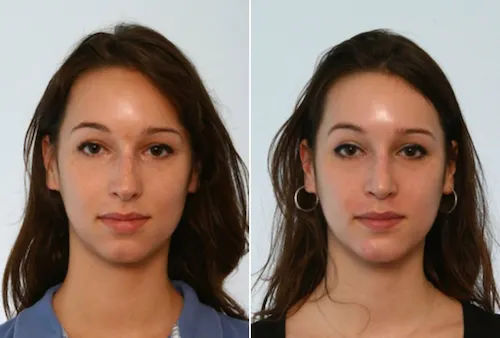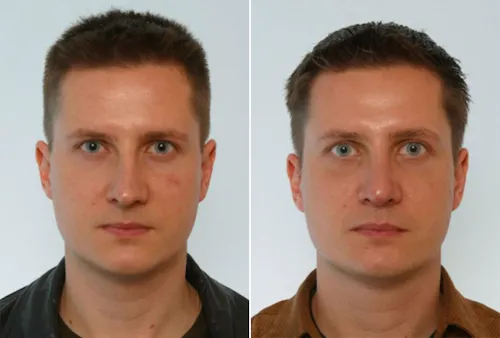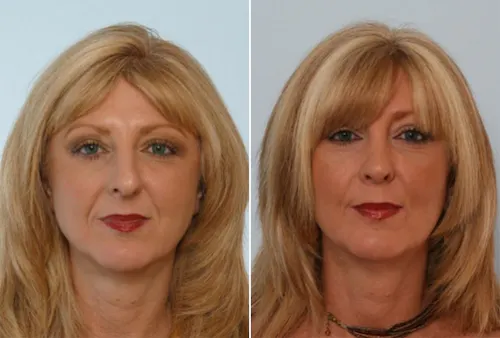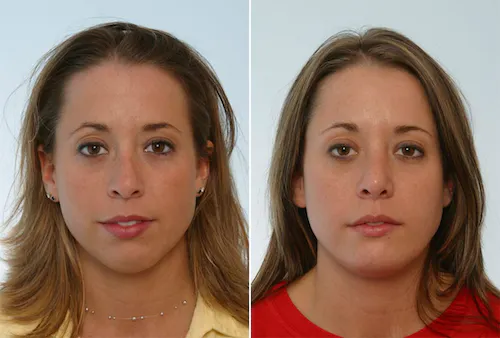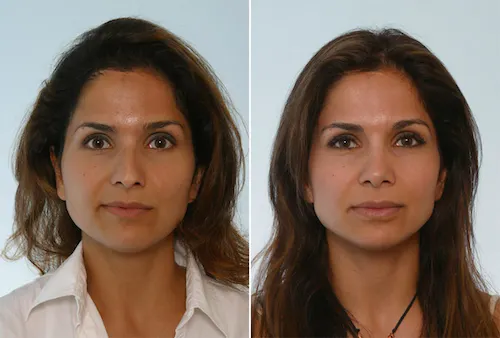35+ Years of Experience
3k+ Real Patient Reviews
10,000+ Surgeries Performed
Texas Super Doctor
Best Rhinoplasty Surgeon in Houston Texas
Experience the transformative power of rhinoplasty with the best rhinoplasty surgeon in Houston Texas, Dr. Vitenas. Recognized as the best facial plastic surgeon in 2022, Dr. Vitenas combines his artistic eye and surgical expertise to reshape your nose, complementing your unique features and enhancing both aesthetics and function.
Rhinoplasty Before & After Photos
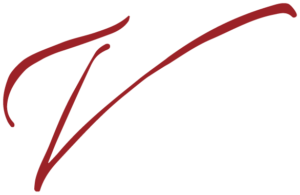
Experience the Comforting
Benefits of Rhinoplasty
Rhinoplasty in Houston, TX, conducted by Dr. Vitenas, offers numerous benefits to patients. The procedure not only enhances the appearance of the nose but also improves its function, leading to an overall better quality of life. Here are some of the key benefits:
IMPROVED FACIAL SYMMETRY
Rhinoplasty can correct a crooked or off-center nose, bringing balance and harmony to the face. The procedure can also address issues like a bulbous nasal tip or a bump on the bridge of the nose, contributing to an improved facial appearance.
ENHANCED BREATHING
For patients with a deviated septum or other structural abnormalities, rhinoplasty can significantly improve breathing function. By correcting these issues, patients can experience less difficulty with nasal breathing.
BOOSTED SELF-CONFIDENCE
A well-proportioned nose can enhance a person's self-image and confidence. By addressing cosmetic concerns, rhinoplasty can help patients feel more comfortable and confident in their appearance.
CUSTOMIZED OUTCOMES
Each rhinoplasty procedure is tailored to the individual patient's needs and aesthetic goals. This personalized approach ensures the results are authentic and natural, enhancing the patient's unique facial features.
LONG-LASTING RESULTS
The results of a rhinoplasty procedure are long-lasting. While the final outcome may take up to a year to fully refine, patients can enjoy the benefits of their new nose for many years to come.
What is Rhinoplasty Surgery?
Rhinoplasty, commonly referred to as a nose job surgery, is a plastic surgery procedure aimed at reshaping the nose through rhinoplasty for both aesthetic enhancement and functional improvement. Beyond altering the nose’s appearance by changing its size, nasal bridge shape, nostril width, and tip refinement, rhinoplasty can also correct birth defects, injuries, and breathing difficulties caused by structural abnormalities.
The procedure can be performed using two primary techniques: open rhinoplasty, which involves an external incision for better visibility, and closed rhinoplasty, where incisions are made internally. Recovery from rhinoplasty entails swelling and bruising, with final results becoming evident as healing progresses over a period of time of several weeks after surgery and months.
It’s crucial for patients to have realistic expectations and undergo thorough rhinoplasty consultations with skilled surgeons to personalize the surgical approach according to their unique facial structure and desired outcomes.
Ideal Candidates for Rhinoplasty in Houston, TX
Rhinoplasty is a transformative surgical procedure that can significantly enhance facial aesthetics and improve nasal function. However, it’s essential to understand that not everyone is an ideal candidate for this procedure. Here are some characteristics of potential candidates who can benefit most from rhinoplasty:
- Individuals who are dissatisfied with the appearance of their nose after rhinoplasty, including its size, shape, or proportions in relation to other facial features.
- Patients experiencing functional issues, such as a deviated nasal septum, which can lead to troubled breathing or sleeping.
- Those who have suffered nasal trauma or injury resulting in a crooked or off-center nose.
- Individuals with a bulbous, upturned, or drooping nasal tip, excessively flared nostrils, or a bump on the nasal bridge.
- Patients who are in overall good health and do not have any medical reasons that could complicate surgery or recovery.
- Individuals who have a positive outlook and realistic expectations about the outcome of the surgery.
- Non-smokers or those willing to quit smoking for a period of time before and after the procedure, as smoking can interfere with the healing process.
The Rhinoplasty Procedure
The rhinoplasty procedure is a complex facial plastic surgery procedure that requires a skilled surgeon like Dr. Vitenas to achieve optimal results. The process involves several stages, each crucial in obtaining the desired aesthetic and functional outcomes. Here’s a detailed look at what to expect:
- Consultation: This initial meeting with Dr. Vitenas allows you to discuss your aesthetic goals, medical history, and any concerns you may have. This step is crucial in determining the best surgical approach for your specific needs.
- Preoperative Preparation: In the weeks leading up to your surgery, you’ll be given specific instructions to follow. These may include stopping certain medications, avoiding alcohol and tobacco, and arranging for someone to drive you home after the procedure.
- Anesthesia: To ensure your comfort during the procedure, general anesthesia is administered. This will keep you comfortable and pain-free throughout the surgery.
- Incisions: Depending on the specific surgical plan, Dr. Vitenas will make either internal incisions (for a closed rhinoplasty) or an additional small incision on the underside of the nose (for an open rhinoplasty).
- Reshaping the Nose: Using meticulous attention and surgical skill, Dr. Vitenas will reshape the nasal structures to achieve the desired outcome. This can involve reducing or augmenting nasal structures with grafts, straightening the septum, or reshaping the nasal tip or bridge.
- Closure: Once the reshaping is complete, the incisions are carefully closed to minimize visible scarring. Internal splints may be applied to help the nose maintain its new shape during the healing process.
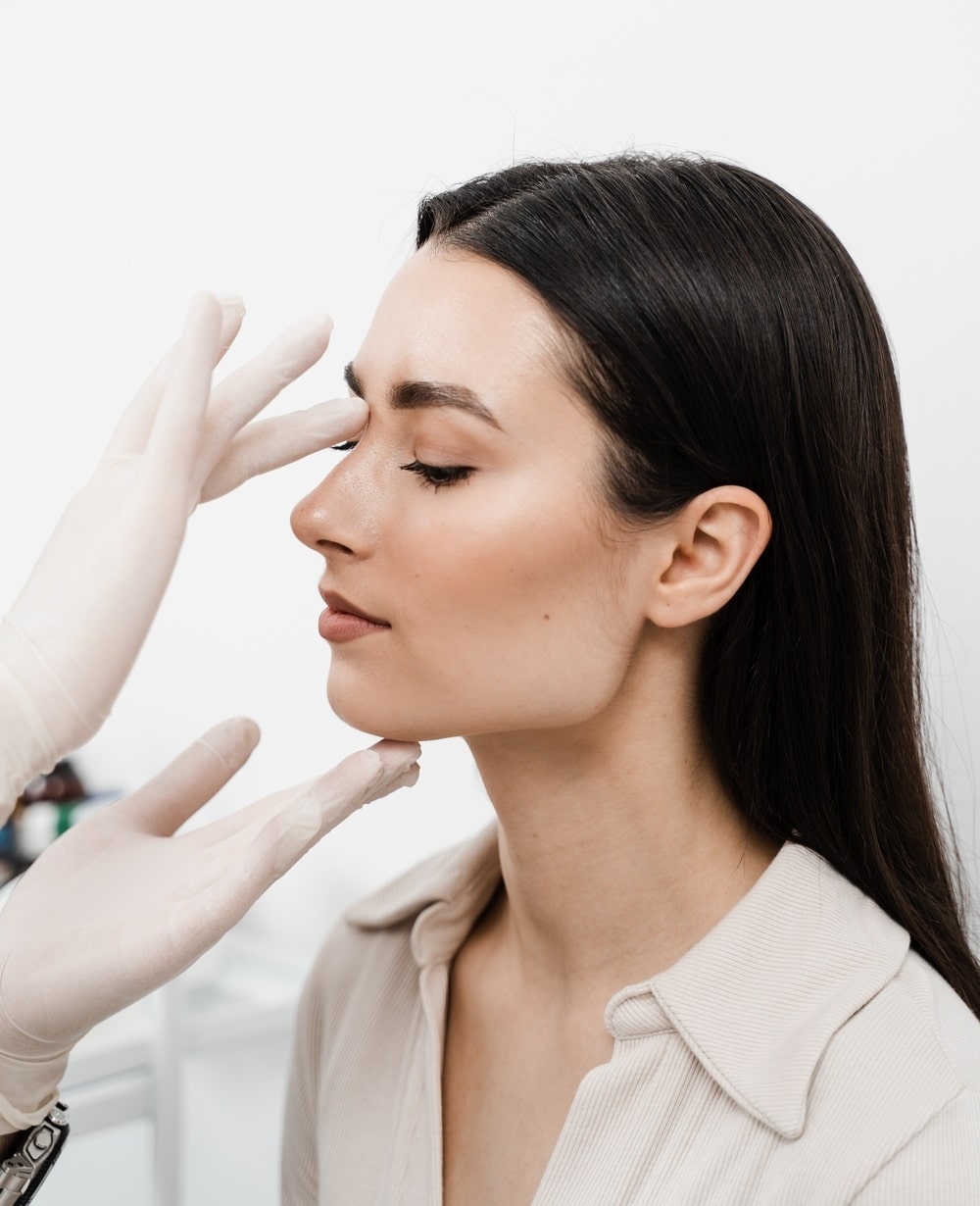
Recovery After Rhinoplasty Surgery
Recovery is a vital stage of any procedure in facial plastic surgery in Houston, and rhinoplasty is no exception.
After your procedure, you’ll begin the rhinoplasty recovery process. This period is critical for ensuring the best possible results and minimizing potential complications. In the first few days following surgery, you may experience some swelling, bruising, and mild discomfort, which can be managed with prescribed medications. It’s important to rest and avoid strenuous activity during this time to promote healing.
Around rhinoplasty recovery day 7, any external stitches, and the nasal splint will be removed. Most patients feel comfortable returning to work and normal daily activities at this point, although strenuous physical activity should be avoided for 4-6 weeks. Over the next several weeks, the swelling will continue to decrease, and you’ll start to see the new shape of your nose. It’s important to continue following all post-operative care instructions during this time and attend all follow-up appointments with Dr. Vitenas.
Dr. Vitenas was voted the Best Facial Plastic Surgeon in Houston for 2022 by Modern Luxury Magazine!

Results of Rhinoplasty in Houston, TX
Rhinoplasty can significantly improve both the appearance and functionality of your nose, enhancing your overall facial symmetry and boosting your self-confidence. It’s important to note that the full results of a rhinoplasty procedure may not be completely visible until all swelling has subsided, which can take up to a year post-surgery.
The procedure can correct a wide range of cosmetic concerns, including a crooked nose, a bulbous nasal tip, a dorsal hump, or a nose that appears too large or small in proportion to other facial features.
Many rhinoplasty patients report experiencing improved breathing functionality following their nose surgery. This is particularly beneficial for those who previously struggled with a deviated septum or other structural abnormalities that caused breathing problems.
Rhinoplasty is a powerful tool for boosting self-confidence, as it allows patients to feel more comfortable and satisfied with their appearance. The final result is a beautiful nose that looks better and a functional nose that functions better, leading to improved quality of life.
Cost of Rhinoplasty Surgery
The cost of a rhinoplasty procedure in Houston, TX, begins at $14,000 and can vary widely. This variation is due to factors like the surgery’s complexity, the surgeon’s expertise, and the facilities used.
It’s important to remember that rhinoplasty is a highly personalized procedure, and the cost will reflect the individual patient’s needs and goals. Factors that can influence the cost include the type of rhinoplasty performed (primary or revision), whether it’s a closed or open procedure, and the extent of correction required.
Additional procedures, such as chin augmentation or cartilage grafting, may also influence the overall cost. Additional costs may also include anesthesia fees, surgical facility costs, and medications for post-operative care. Cost is an important factor to consider, but it should not be the sole determining factor.
Choosing a highly skilled and experienced rhinoplasty surgeon like Dr. Vitenas can ensure a successful outcome and minimize the risk of complications or the need for revision rhinoplasty, which can ultimately save you money in the long run.
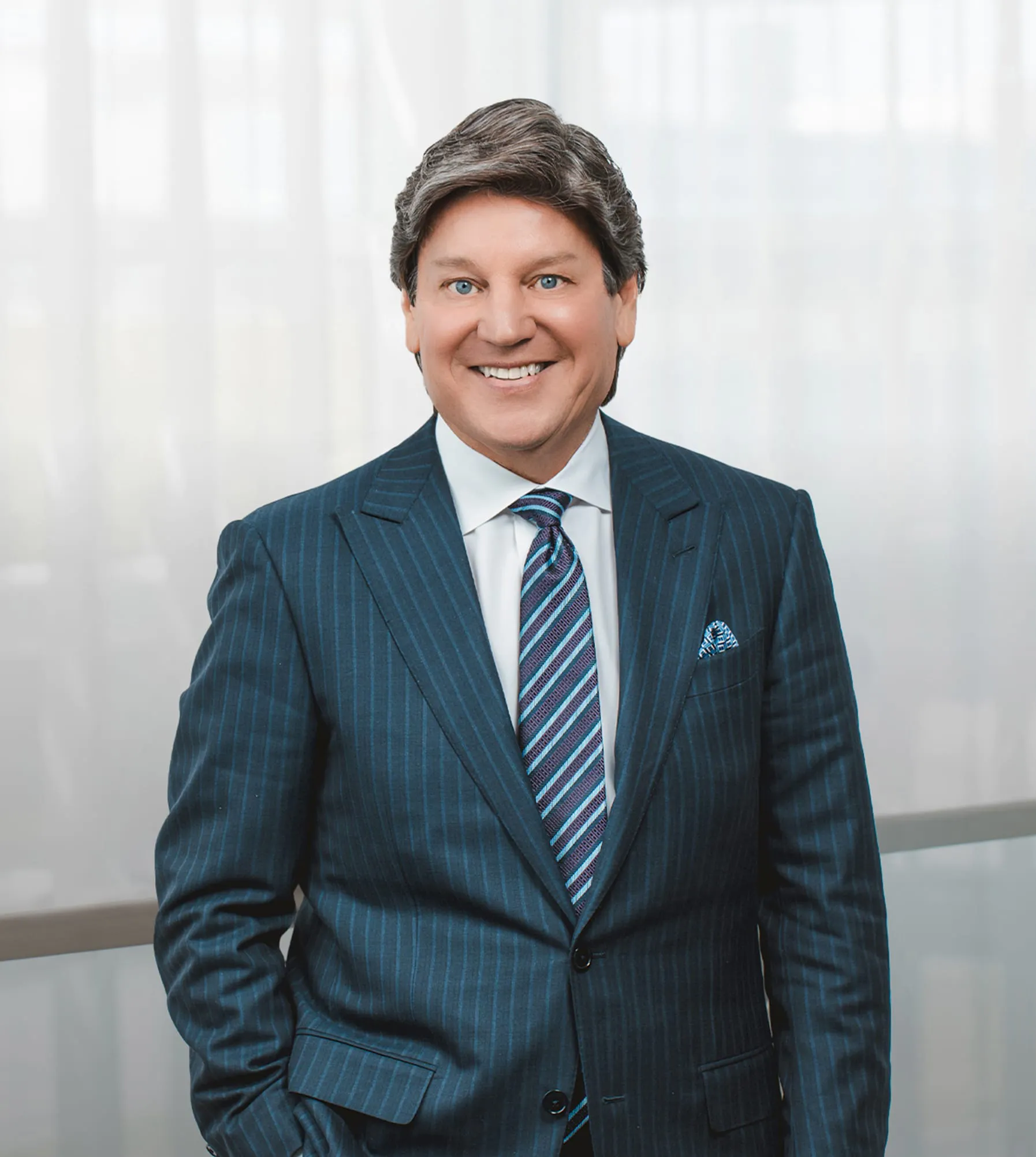

Why Choose Dr. Vitenas For Your Rhinoplasty in Houston, TX?
Choosing the right surgeon for your rhinoplasty procedure is crucial to achieving the best possible outcome. Dr. Vitenas is a renowned board-certified plastic surgeon with over 35 years of experience in cosmetic surgery.
Here are a few reasons why Dr. Vitenas is the top choice for rhinoplasty in Houston, TX:
- Extensive experience and expertise in a wide range of rhinoplasty techniques, ensuring a personalized approach tailored to each patient's unique needs and goals.
- A proven track record of excellent patient outcomes, as evidenced by his 4.9-star rating with 800 reviews.
- Recognized by Modern Luxury Magazine as the Best Facial Plastic Surgeon in Houston in 2022.
- Recipient of numerous awards, including Patient’s Choice Awards, America’s Most Compassionate Doctors, and the Best Single Physician Practice recognition.
- Deeply involved with the Houston community, partnering with various local and national charities and small businesses.
Choosing Dr. Vitenas for your rhinoplasty in Houston, TX, ensures that you are in the hands of a skilled, experienced, and compassionate surgeon who is committed to delivering the best possible results and patient care.
Rhinoplasty FAQ
What is the cost of a nose job in Houston, Texas?
Rhinoplasty, also known as a nose job, is performed for various reasons related to the size and shape of the nose. The price can differ based on the surgical approach needed to achieve the patient's goals.
The starting cost for a nose job is typically around $14,000. For a more detailed estimate of the procedure's cost, you are encouraged to submit photos through our contact form, along with your contact details and a brief explanation of your surgical objectives. This allows the doctor to assess your case and provide a cost estimate tailored to your specific anatomical needs.
Who is an ideal candidate for rhinoplasty?
Ideal candidates for rhinoplasty are individuals who are unhappy with the appearance of their nose profile, are in good health, have realistic expectations about the results, and understand the reasons for undergoing the procedure. In addition, candidates should be in overall good health, non-smokers, and not have any medical conditions that could interfere with the healing process.
What is the recovery process like after a rhinoplasty?
The recovery process after a rhinoplasty typically takes about two weeks, during which time swelling and bruising will gradually subside. Days after surgery, patients may experience mild discomfort in the initial hours after the surgery, which is manageable with medication. The full results of the procedure become visible about a year after surgery, once all swelling has subsided.
What are the potential risks and complications of rhinoplasty?
Like any surgical procedure, rhinoplasty carries potential risks and complications. These may include infection, scarring, altered skin sensation, bleeding, fluid accumulation, post-operative breathing difficulties, and nasal asymmetry. Choosing a highly skilled and experienced surgeon like Dr. Vitenas can minimize these risks.
How long does a rhinoplasty procedure take?
The duration of a rhinoplasty procedure varies depending on the level of correction needed. Generally lasting between 1-3 hours, the surgery for patients is performed under general anesthesia for patient comfort and safety. This timeframe allows the surgeon to meticulously address the specific adjustments required to achieve the desired aesthetic, as well as the functional outcomes for the patient's nose.
Where are the cuts made during rhinoplasty surgery?
In rhinoplasty surgery, the incisions are typically made inside the nostrils (endonasal approach) or across the tissue between the nostrils (external approach). The choice depends on the surgeon's technique and the desired changes. Internal incisions leave no visible scars, while external ones might result in a small scar at the base of the nose. Surgeons then access the cartilage and bone to reshape and refine the nose's structure, achieving the desired aesthetic and functional outcomes.
How can I pay for my rhinoplasty at Vitenas Cosmetic Surgery?
Vitenas Cosmetic Surgery welcomes payment in cash and major credit cards. In addition, eligible individuals have access to financing choices. Get in touch with a patient coordinator to learn further about medical financing via CareCredit or Alphaeon Credit.



